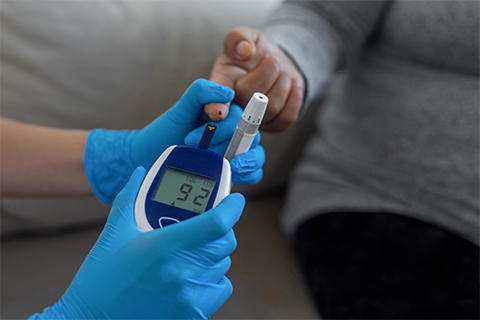From the journals: MCP
Unlocking a metabolic disorder mystery. The many roles of lactate. Tools can unveil dementia biomarkers. Read about papers on these topics recently published in the journal Molecular & Cellular Proteomics.
Unlocking a metabolic disorder mystery
In metabolic disorders, the human body’s process of making energy and building blocks from the food we eat is disrupted. Metabolic disorders such as Type 2 diabetes and insulin resistance are growing in prevalence, causing severe health complications that decrease quality of life and increase health care costs.
These disorders are connected to imbalances in glucose and lipid metabolism, which are tightly regulated by various signaling pathways and proteins called transcription factors. cAMP response element binding protein, or CREB, regulated transcription coactivator 2, or CRTC2, is essential in maintaining glucose homeostasis and controlling energy metabolism. However, researchers know little about the mechanism of its action.

In a recent article published in the Molecular and Cellular Proteomics, Jae Min Lim and researchers from the Korea University and the Kyung Hee University describe how they addressed this knowledge gap. They genetically altered mice to delete Crtc2 expression in the liver, but not in other tissues and fed them with a high-fat diet to study global proteome changes using liquid chromatography-tandem mass spectrometry, or LC-MS/MS, analysis and protein–protein interactions.
The team found that multiple proteins were differentially regulated in the knockout mice compared to the control mice when both were fed a high-fat diet. These proteins further led to altered glucose and lipid metabolism in the Crtc2 knockout mice. Using these proteins as a guide and computational tools, the researchers created a protein–protein interaction network to identify possible CRTC2 interaction partners.
They identified sterol regulatory element-binding transcription factor 1, or SREBF1, a key transcription factor that controls cholesterol biosynthesis and lipid homeostasis, as a direct interacting partner with CRTC2. They confirmed the cooperation between the two partners, CRTC2 and SREBF1, in a reporter assay where sterol regulatory element binding activity increased when they added CRTC2 to the liver cells.
The authors concluded that CRTC2 and SREBF1 cooperation can fine-tune cellular response to metabolic stress. This study also highlights the importance of understanding the mechanism behind tightly regulated glucose metabolism, paving the way to explore CRTC2 as a potential drug target for insulin resistance and diabetes.
The many roles of lactate
The central metabolic pathway, glycolysis, converts glucose in our food to provide fuel. One critical product of glycolysis is lactate, which performs multiple roles in the cell. It serves as a carbon source for making raw materials in the cell, a signaling molecule, and an immune response regulator.
With the advent of new technology and high-throughput omics, researchers have found that lactate participates in metabolic reprogramming to adjust for changes in the cellular environment and protein lactylation, an epigenetic modification.
In a review published in the journal Molecular & Cellular Proteomics, Zhimin Wang and a multinational team at the Zhengzhou University and Tsinghua University in China, and the University of Copenhagen, Denmark, dive deep into the metabolic fate of lactate-derived carbon, the cross talk between glycolysis and mitochondrial energy production, and lactylation. The team also discusses the role of excess lactate in inducing an acidic microenvironment in the cell, leading to differences in immune cell activation.
Lastly, the authors discuss protein lactylation's role in human diseases and disorders such as infections, cancer, fibrosis and heart failure. They argue that combining the study of histone acetylation sites and the metabolomics of lactates might open doors for future research and potential therapeutic targets.
Tools can unveil dementia biomarkers
Dementias are chronic conditions characterized by progressive loss of nerve cells and their connections within the brain, leading to loss of memory and decline in cognitive functions. In 2023, Alzheimer’s and other dementias will cost the nation $345 billion in medical costs, excluding unpaid caregiving hours. By 2050, these costs are expected to rise to nearly $1 trillion – creating an urgent need to develop biomarkers for early diagnosis, treatment prognosis and defining effective inclusion and evaluation criteria for clinical trials.
Researchers can choose from a growing number of technologies when designing studies to find novel fluid-based biomarkers. In a review published in Molecular & Cellular Proteomics, Charlotte E. Teunissen and the team at MIRIADE Consortium provide an overview of available technologies for biomarker discovery in clinical and research settings.
They break down each method's analysis principle, instrumentation set-up, strengths, limitations and future perspectives. The authors also discuss the advantages of tailoring multiple technologies in a complementary way to answer specific questions of interest.
Enjoy reading ASBMB Today?
Become a member to receive the print edition four times a year and the digital edition monthly.
Learn moreGet the latest from ASBMB Today
Enter your email address, and we’ll send you a weekly email with recent articles, interviews and more.
Latest in Science
Science highlights or most popular articles

Fueling healthier aging, connecting metabolism stress and time
Biochemist Melanie McReynolds investigates how metabolism and stress shape the aging process. Her research on NAD+, a molecule central to cellular energy, reveals how maintaining its balance could promote healthier, longer lives.

Mapping proteins, one side chain at a time
Roland Dunbrack Jr. will receive the ASBMB DeLano Award for Computational Biosciences at the ASBMB Annual Meeting, March 7–10, just outside of Washington, D.C.

Exploring the link between lipids and longevity
Meng Wang will present her work on metabolism and aging at the ASBMB Annual Meeting, March 7-10, just outside of Washington, D.C.

Defining a ‘crucial gatekeeper’ of lipid metabolism
George Carman receives the Herbert Tabor Research Award at the ASBMB Annual Meeting, March 7–10, just outside of Washington, D.C.

The science of staying strong
Muscles power every movement, but they also tell the story of aging itself. Scientists are uncovering how strength fades, why some species resist it and what lifestyle and molecular clues could help preserve muscle health for life.

Bacteriophage protein could make queso fresco safer
Researchers characterized the structure and function of PlyP100, a bacteriophage protein that shows promise as a food-safe antimicrobial for preventing Listeria monocytogenes growth in fresh cheeses.

